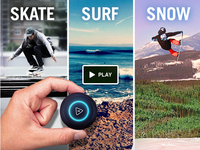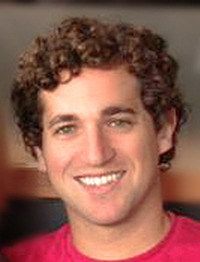Monday, August 5, 2013
Tracking Action Sports With ActiveReplay's Trace Sensor, with David Lokshin

There are lots of "pie in the sky" projects on Kickstarter, the crowdsourcing site--with many devices that you sometimes wonder if they're possible, or if they'll ever get to market. Unlike those, however, one of the latest projects, ActiveReplay (www.activereplay.com) has some serious, experienced executives behind it, who have the experience in designing hardware devices--in the form of CEO Dr. Anatole Lokshin, who helped create the consumer GPS market as the CTO of Magellan Navigation. We spoke with co-founder and VP of Products David Lokshin about the Los Angeles company and its Kickstarter project.
What's the idea behind ActiveReplay?

David Lokshin: The gist of it, is we make action sports shareable and comparable. Runners and bicyclists have all kinds of gadgets now showing how fast they're going, and where they've gone, but action sports have none of that. The information in action sports is way more interesting, for example, if you're snowboarding on a mountain and getting airtime, surfers getting cutbacks, and all these things. With action sports, there's much more than how fast you're going. That's what we're bringing that to action sports.
It's unusual to see a Kickstarter with someone like Dr. Lokshin involved. How did that happen?
David Lokshin: Anatole was VP and CTO of Magellan Navigation for more than a decade. He had joined Magellan when it was a startup, looking to map GPS omnipresent and have it be everywhere. Over the course of those years, he developed the first, consumer GPS digital mapping, then 3D car navigation. A few years agoa, he stepped back. We started thinking about what the next step was in the market, because GPS is now very commonplace, and it's a commodity. We figured out that inertial sensors are the next step. That makes a few interesting applications possible, for example, in action sports, because there you're not running in a straight line at a constant speed. Your speed is variable, and you're not going straight. I grew up participating in action sports, and Anatole is a very avid skiier. I grew up surfing, snowboarding, and more, and growing up with those sports, it's hard to share those kinds of accomplishments. With action sports, right now, you can't say you were up in the air for 1.5 seconds, or 0.5 seconds. None of that is measurable. We started working on this at night. Now, AlpineReplay has hundreds of thousands of people at 14,000 resorts all over the world, and we're now porting that to more action sports.
With that kind of background, why did you decide to use Kickstarter?
David Lokshin: There are a few reasons we went with Kickstarter. Anatole has shipped millions of units of consumer hardware over the last decade. One things he know, is what inventory can do. With Kickstarter, it's a great way to gauge the interest in the product, so we can figure out the first production run. We're a bootstrapped company, and we've never taken a dime of outside investment. One of the great things about crowdfunding, it's a great platform to start marketing, and find backers for what you're building. That allows you to focus on the product, making sure it's amazing and works as promised.
How far along are you on your project?
David Lokshin: We're very far along. We pretty much have the PC board finalized, and the industrial design finalized. We're now tweaking our manufacturing, and have made dozens of prototypes of our Trace device. However, when you go from making dozens of handmade units to thousands, it takes a little bit of time. We hope to have our first shipments in January, about six months from now. That's our main production launch. During that time, we're working with manufacturers to make sure we have the right process in place to go from a handmade dozen to thousands.
How did you connect with Dr. Lokshin?
David Lokshin: We connected, because of genetics--he's my dad. It's actually funny, we both quit our jobs on the same day, without telling each other. He had been consulting, I had been consulting, and we both began thinking about what to do. We're now both full time on this. My background is an applied math degree I received in 2008 at Harvard. I then traded options for Barclays Bank, but wanted to do something different.
Did you ever think you'd start a company with your dad?
David Lokshin: Everyone always asks you that. I just happened, but now, I couldn't have imagined starting a company with someone you're not related to. It's amazing the amount of faith you need to have in a co-founder, it's crazy not to do it with someone you know as well as your father.
How hard was it to develop the hardware here?
David Lokshin: The secret sauce is actually really in the software. The hardware only recently has become small enough and durable enough to do this. If you want to put something on a skateboard, you don't want to mess up the balance of the board. If you're rotating that board, you don't want to do anything to change the balance. However, the really hard part is the software. We have a 9-axis, inertial sensor which is collecting all of this data. It's nontrivial to parse all of that data, and identify the tricks. What's the signature for a kick flip? What's the signature for a cutback? Things like that. Like any startup, we have an engineering team. What's different, is we also have a math team, with two Ph.D.'s in theoretical mechanics looking at all that sensor data, and building the algorithms to detect the signatures. Everyone on our team, including our computer science engineers, actually all have a background in mathematics and physics. We take that part very seriously. I think we're way ahead of the curve in that regard.
What's the ultimate goal for your company?
David Lokshin: I think, when we look at it, we really want to change the way people participate in action sports, and also in the way spectators view action sports. Action sports are really glamorous--look at things like everything sponsored by Red Bull, the Winter Olympics, the X Games--but lots of people haven't actually participated in those sports, and they don't really know what they're watching. If you'll look at our Kickstarter video, there's a section there that shows a snowboarder, with his speed on the left hand side, and his jump status on the right hand side. There is other technology which will overlay stats on a video, but none does so in the way we have. They use a camera to measure the stats. Instead, what we do, is we track a performance directly and sync that with the video. I think that will let people who don't participate get a much better perspective of how insane the things action sports people are doing. The other part, is that action sports never really have had this data, and there's no reason why the same change that came with running and biking won't also happen with these sports.
Thanks!